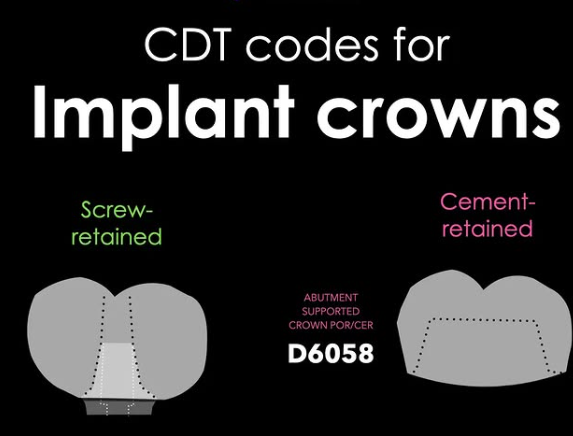The Comprehensive Guide to Dental Codes for Implant Crowns: Porcelain, Cement, Repair, and Seating
1. Introduction to Dental Implant Crowns and Coding
Dental implant crowns have revolutionized restorative dentistry, offering patients a durable and aesthetically pleasing solution for missing or damaged teeth. However, the process of billing and coding for these procedures can be complex, requiring a deep understanding of the specific codes used for different aspects of implant crown treatment.
This article delves into the intricacies of dental codes for implant crowns, focusing on four key areas: porcelain crowns, cementation, repair, and seating. Whether you’re a dental professional, a billing specialist, or a patient seeking clarity, this guide will provide you with a comprehensive understanding of the topic.

2. Dental Code for Implant Crown: Porcelain
What is a Porcelain Implant Crown?
A porcelain implant crown is a type of dental restoration that mimics the natural appearance of teeth. Made from high-quality ceramic materials, these crowns are known for their durability and aesthetic appeal. They are often used in visible areas of the mouth, such as the front teeth, where appearance is a priority.
Relevant Dental Codes
The American Dental Association (ADA) provides specific codes for porcelain implant crowns. The most commonly used code is:
- D6058: Implant-supported porcelain/ceramic crown
This code is used when a porcelain crown is attached to an implant abutment. It covers the fabrication and placement of the crown, ensuring that the procedure is accurately documented for billing purposes.
Factors Affecting the Cost of Porcelain Implant Crowns
The cost of a porcelain implant crown can vary based on several factors, including:
- The complexity of the case
- The quality of the materials used
- The geographic location of the dental practice
- The experience of the dentist
Comparison of Porcelain Crown Codes
| Code | Description | Typical Use Case |
|---|---|---|
| D6058 | Implant-supported porcelain/ceramic crown | Front teeth, aesthetic focus |
| D6059 | Implant-supported porcelain-fused-to-metal crown | Molars, durability focus |
3. Dental Code for Implant Crown: Cement
The Role of Cement in Implant Crowns
Cementation is a critical step in the placement of implant crowns. It involves using dental cement to securely attach the crown to the implant abutment. Proper cementation ensures the longevity and stability of the restoration.
Relevant Dental Codes
The ADA provides specific codes for cementation procedures:
- D2950: Core buildup, including any pins
- D6052: Implant abutment supported porcelain/ceramic crown
While there is no specific code for cementation alone, it is typically included in the overall procedure code for crown placement.
Types of Dental Cement
There are several types of dental cement used in implant crown procedures, including:
- Resin-based cement: Offers strong bonding and durability.
- Glass ionomer cement: Provides fluoride release, which can help prevent decay.
- Zinc phosphate cement: Known for its long-term stability.
4. Dental Code for Implant Crown: Repair
Common Reasons for Implant Crown Repair
Implant crowns are designed to last for many years, but they may occasionally require repair due to:
- Chipping or cracking of the porcelain
- Loosening of the crown
- Wear and tear over time
Relevant Dental Codes
The ADA provides specific codes for repair procedures:
- D6080: Implant crown repair
- D6081: Implant crown recementation
These codes ensure that the repair process is accurately documented and billed.
Steps in the Repair Process
- Assessment: The dentist examines the crown to determine the extent of the damage.
- Repair or Replacement: Depending on the damage, the crown may be repaired or replaced.
- Recementation: If the crown has loosened, it is reattached using dental cement.
5. Dental Code for Implant Crown: Seating
What is Crown Seating?
Crown seating refers to the final placement of the implant crown onto the abutment. This step ensures that the crown fits properly and functions as intended.
Relevant Dental Codes
The ADA provides specific codes for crown seating:
- D6057: Implant-supported crown placement
This code covers the entire process of seating the crown, including any adjustments needed to ensure a proper fit.
Importance of Proper Seating
Proper seating is crucial for:
- Ensuring the crown fits comfortably
- Preventing bite issues
- Maximizing the longevity of the restoration
6. Conclusion
Understanding dental codes for implant crowns is essential for accurate billing and documentation. From porcelain crowns to cementation, repair, and seating, each aspect of the procedure has its own specific code. By familiarizing yourself with these codes, you can ensure that your practice runs smoothly and that your patients receive the best possible care.
7. FAQs
Q1: What is the difference between D6058 and D6059?
A1: D6058 refers to a porcelain/ceramic crown, while D6059 refers to a porcelain-fused-to-metal crown. The latter is often used for molars due to its durability.
Q2: Is cementation included in the crown placement code?
A2: Yes, cementation is typically included in the overall procedure code for crown placement.
Q3: How often do implant crowns need repair?
A3: With proper care, implant crowns can last for many years without needing repair. However, occasional repairs may be necessary due to wear and tear.
8. Additional Resources
- American Dental Association (ADA): www.ada.org
- International Congress of Oral Implantologists (ICOI): www.icoi.org
- Journal of Prosthetic Dentistry: www.journals.elsevier.com


